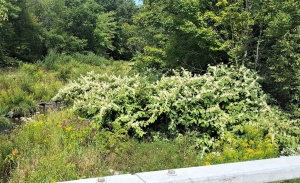A Plowed Field – Aug. 29, 2024.
Geology of a plowed field?
The Catskill Geologists; The Mountain Eagle – Oct. 25, 2018
Robert and Johanna Titus
We are not farmers, so we don’t know why farmers plow their fields at this time of the year. But, as geologists, we do know what to look for when they do. In fact, it is not unusual for us to slow down and take a good look at a newly plowed field; Whatever are we looking for? Well, not surprisingly, we are exercising our trained eyes. And today, we would like to help you do the same.
Recently we were driving south, down Rte. 9G toward Hyde Park, when we saw the freshly plowed field in our first photo. Take a look; what do you see? Or, rather, what do you not see? We always like to say “the hardest thing to see in science is that which is not there. Take another look at our photo: what is not there? You are probably going to kick yourself when you miss this.

The answer is that there are no rocks lying on the ground. Isn’t that just a little strange? What happened the last time you did some digging? You probably hit “two rocks for every dirt,” right? So, what happened to those two rocks? Actually, they were never there. It turns out we had been driving along an old glacial lake. Lake deposits are almost all silt and clay. There are no rocks. That glacial lake has a name; it was Glacial Lake Albany and, back at the end of the Ice Age, it flooded much of the Hudson Valley, including our location along Rte. 9G. Its waters are long gone; they drained away. But the old silts and clays are all still there. One way to identify them is to wait for plowing and watch for that absence of cobbles. We like to pull over, get out and, in our mind’s eyes, gaze at the lake that we and perhaps only we, can envision.
Let’s take you to another location along the highway, Rte. 9, just south of Rhinebeck. Now your newly trained eyes probably won’t have much trouble in seeing what is there: rocks, and lots of them. What happened here? Why is this so different? This is another wide flat landscape, and you might be tempted to interpret it as another old lake bottom. But, don’t forget all those silts and clays of lake bottoms. This flat surface is quite likely a floodplain. Flood plains often are stony like this one. Floodplain deposits are generally deposited by flowing river waters. There are a lot more floodplains on his planet than glacial lakes so there is no surprise here.

So, why are we talking about sediments east of the Hudson; that’s pretty far away. Well. don’t forget we are here to train your eyes. We would like it very much if you began paying attention to flat landscapes, especially when they are plowed fields. There will be a lot of them come next spring, and that likely includes places around where you live.
Contact the authors at randjtitus@prodigy.net. Join their facebook page “The Catskill Geologist.”

 Japanese knot weed
Japanese knot weed









